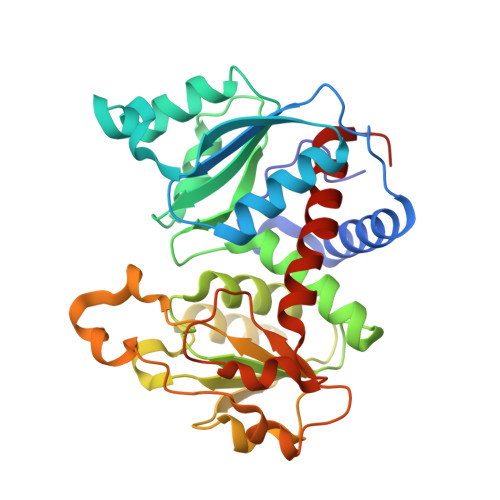A cooperative Escherichia coli aspartate transcarbamoylase without regulatory subunits .
Mendes, K.R., Kantrowitz, E.R.(2010) Biochemistry 49: 7694-7703
- PubMed: 20681545
- DOI: https://doi.org/10.1021/bi1010333
- Primary Citation of Related Structures:
3NPM - PubMed Abstract:
Here we report the isolation, kinetic characterization, and X-ray structure determination of a cooperative Escherichia coli aspartate transcarbamoylase (ATCase) without regulatory subunits. The native ATCase holoenzyme consists of six catalytic chains organized as two trimers bridged noncovalently by six regulatory chains organized as three dimers, c(6)r(6). Dissociation of the native holoenzyme produces catalytically active trimers, c(3), and nucleotide-binding regulatory dimers, r(2). By introducing specific disulfide bonds linking the catalytic chains from the upper trimer site specifically to their corresponding chains in the lower trimer prior to dissociation, a new catalytic unit, c(6), was isolated consisting of two catalytic trimers linked by disulfide bonds. Not only does the c(6) species display enhanced enzymatic activity compared to the wild-type enzyme, but the disulfide bonds also impart homotropic cooperativity, never observed in the wild-type c(3). The c(6) ATCase was crystallized in the presence of phosphate and its X-ray structure determined to 2.10 A resolution. The structure of c(6) ATCase liganded with phosphate exists in a nearly identical conformation as other R-state structures with similar values calculated for the vertical separation and planar angles. The disulfide bonds linking upper and lower catalytic trimers predispose the active site into a more active conformation by locking the 240s loop into the position characteristic of the high-affinity R state. Furthermore, the elimination of the structural constraints imposed by the regulatory subunits within the holoenzyme provides increased flexibility to the c(6) enzyme, enhancing its activity over the wild-type holoenzyme (c(6)r(6)) and c(3). The covalent linkage between upper and lower catalytic trimers restores homotropic cooperativity so that a binding event at one or so active sites stimulates binding at the other sites. Reduction of the disulfide bonds in the c(6) ATCase results in c(3) catalytic subunits that display kinetic parameters similar to those of wild-type c(3). This is the first report of an active c(6) catalytic unit that displays enhanced activity and homotropic cooperativity.
Organizational Affiliation:
Department of Chemistry, Boston College, Merkert Chemistry Center, Chestnut Hill, Massachusetts 02467, USA.















